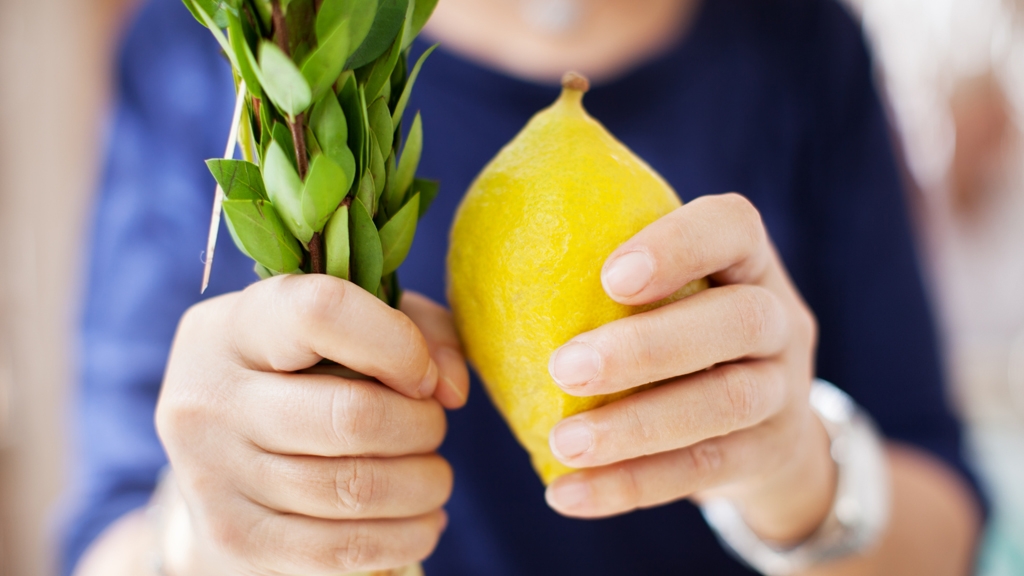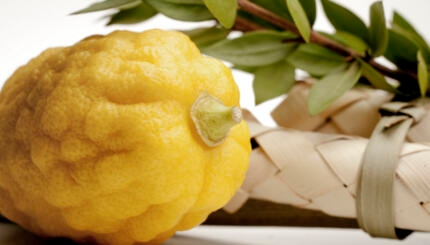As we now practice the ritual of the aravah [willow that is beat on Hoshanah Rabbah], additional aravot [willows] are provided to the worshipers just after the seven hakafot [processions around the synagogue] with the and , the last time the Arba’ah Minim are used that year. As the Hazan recites, “A voice brings tidings and says,” the congregation strikes their aravot on the floor or against a solid object.
It has become customary to strike five times, assuring that some of the leaves fall from the stem. There is no berakhah to be recited for beating the willows, and no uniformity about the required number of willows or beatings necessary. The silence that surrounds this practice, the diverse ways it can be implemented all underscore how strange this ritual is. With no real context, how is this momentary violence to be explained? Why do we beat the willow?
The , affirms a special ritual involving the willows in the Temple, one that involved decorating the altar, parading around it seven times on Hoshanah Rabbah, possibly carrying the willows while marching. The suggests that there was also a practice of beating the willows on that day, although it also affirms that this practice was not universally accepted.
What the Mishnah doesn’t provide is a reason for the practice of beating the willows. Why is this strange ritual required? Particularly because its origin is so questionable, justifying its practice is all the more intriguing. One suspects that the diverse accounts of how the practice originated and of what the practice actually entails suggests that the sages were confronting a practice whose purpose they really didn’t know.

Help us keep Jewish knowledge accessible to millions of people around the world.
Your donation to My Jewish Learning fuels endless journeys of Jewish discovery. With your help, My Jewish Learning can continue to provide nonstop opportunities for learning, connection and growth.
That suspicion in only compounded by the multiplicity of justifications that are offered across the ages. Were any one reason conclusively true, the others would have become unnecessary. That no one reason commanded (or commands) broad assent suggests that the plausible explanation of this practice has not yet emerged.
A brief examination of the explanations, both medieval and modern, reveals the ingenuity and the confusion of rabbinic authorities is the face of explaining havatat aravot [beating the willows].
The Sefer ha-Toda’ah candidly concedes that there is not rational explanation for the [custom] and the Minhagei Yeshurun sees it as a symbol of the ability of the Jewish people so survive persecution: No matter how hard we beat the aravot, the branch somehow persists. Hayyei Avraham suggests that the beating of the willow symbolizes the beating we deserve when we violate the mitzvot.
Rabbi Abraham Millgram suggests that beating the willows “may have once been connected with rain-bringing rituals.” While there is explicit rabbinic writings connecting Hoshanah Rabbah with rain, there is nothing extant to indicate why the willow beating would symbolize rain. If this was once an apotropaic rite in which our ancestors induced rain by making it “rain” leaves, there is no ancient testimony to confirm that supposition.
Echoing the Rambam (Maimonides), Rabbi Millgram also affirms that “its meaning is the synagogue ritual is the remembrance of the Temple service, the awareness of the Temple’s destruction, and the hope of its restoration.” While there is Talmudic testimony that we continue the hakafot on this day in memory of the Temple, there is no suggestion that the willow beating memorializes the old Temple of reflects hope for a new one. Beating branches would be an odd way to express hope in a future rebuilding.
Arthur Waskow offers that “as the leaves fall off the willow, they can be seen today as a symbol of fading, falling lives, or as a symbol of casting off our old and dying sins.” Candidly admitting that his homiletical interpretation lacks support, Waskow’s lovely drash (commentary/interpretation) is a psychological reading into, worthy of reflection but not as an historical explanation of how this rite functioned originally.
Rabbi Elie Munk sees an agricultural and ecological message in the practice: “The procession is made first with the lulav and only thereafter with the special Hoshanot to symbolize our prayerful hope that the blessings of nature be extended to every species of vegetation.” As lovely as this explanation is, the absence of prayers for nature (when there are, indeed, explicit prayers for rain) limits the plausibility of reading the hakafot as originally expressing the hope of natural bounty to all species of plants. In any case, it says nothing about why we beat the aravot after the procession ends.
Basing himself of the which sees the aravot as representing “those insipid creatures of Israel who have neither savior nor perfume,” Rabbi Munk offers an explanation of the willow beating as asserting that God doesn’t desire the death of these sinners, “rather, it is God’s will that they be chastened and tried by bitter blow of fate so that they may learn to walk in the right path once again.”
The beating of the willows, then, represents what should happen to those who sin, in order to inspire them to correct their ways. Unfortunately, the prayer before and after it are messianic and eschatological in content, undermining a sermonic desire to use these branches to whip erring congregants back into line.
Less plausibly, Munk asserts that “this is a means of acting out our wish that in the future Israel may be visited no more by calamity and sorrow.” This reading is more consistent with the contemporary liturgical context for the beating of the willows, but it is hard to see how beating the willow branches can symbolize hope that Israel will yet transcend disaster.
Rabbi Michael Strassfeld sees the beating of the willows as a ritual which “probably symbolized a casting away of sins.” The English Rabbi Isaac Fabricant asserts that “the custom of the beating of the willow is that is symbolizes the ephemeral aspect of life, for as the leaves of the willow drop through beating, so our years in which we are buffeted by the storm and stress of life fall from the span of time allotted to us.”
What all of these lovely “explanations” share is a recourse by psychologizing the ritual (reading it as reflecting as internal human condition) or the theologizing it (as expressing some sentiment toward punishing sinners, forgiving sinners, or establishing the eschaton). None of them explain the texts as we have them, and many of them don’t really explain the specifics of what we actually do with the willow branches. While they might apply to marching with the willows as a memorial to the Temple, none address the violence of the action, or its timing. Why beat them, and why after the last hakafot on Hoshanah Rabbah.
Toward a Simpler Explanation
Rather than reading an inadequately-explained rabbinic ritual against a psychological or spiritual backdrop, invoking categories which were never explicitly delineated in rabbinic thought, a more plausible first try would be to work within the realm of existing rabbinic concern.
Such an approach mitigates against the arrogance of the living, who often impose their core beliefs and assumptions on the ancients. Such an approach also has the advantage of avoiding the seductive appeal of reducing religion to something else (psychology, anthropology, or sociology, for example). Looking at a ritual through the lenses of the ancient rabbis (as best we can), their strong concern is often with the integrity and contours of halakhah [Jewish law]. It is to that realm, then, that we had best look.
I propose that the beating of the willow is motivated by a halakhic desire, in this case to signify the end of the festival and to render its main implement pasul [ritually unfit].
For that reading, there is some suggestive support. First, in the realm of logic (in this instance, the kind of evidence that is both weakest and most suspect), it is noteworthy that the havatah [beating] takes place immediately after the willows are no longer necessary for any ritual purpose. We don’t even wait until the end of the service, but destroy them immediately. That we do so without any prayer or kavanah only strengthens the notion that this minhag [custom] serves a practical purpose, not some deeper symbolic expression.
There is some hint of this practicality in rabbinic texts as well.
The primary support comes from the Mishnah itself. After describing the ritual of the aravot, the next Mishnah informs us that “immediately the children loosened the lulavim and ate their etrogim.” While there is some dispute about the precise meaning of the verb יןשומט, there is no doubt that this practice renders the lulav and the etrog no longer fit for ritual use. Given its propinquity to the passage on the aravot, and given that the havatah is also destructive, it stands to reason that the function is the same: to disqualify the aravot from any further ritual function.
The Shulhan Arukh [a code of Jewish law] supports this supposition when it notes that we are not to beat off all the leaves on the branch, only a few. Hence the havatah only includes beating the aravah once or twice. The purpose pf the ritual is not complete destruction, only preventing its further use. In this regard, the Shulhan Arukh’s understanding of havatat aravot parallels the removal of one tzitzit [fringes] from a tallit [prayershawl] that then becomes pasul [ritually unfit] . Eliyahu Kitov mentions a similar contemporary practice of taking five aravot and beating them five times, after which they are stored in a place where they won’t be trampled “since it is important to cast it away as worthless even after it has been used.”
Conclusion
At stake in this discussion is more then simply uncovering the original reason of a relatively obscure ritual. In contemporary religions homily and study, there is a tendency to filter religious history through the agenda and priorities of the individual examiner. While this is unavoidable to some extent, it often results in the wholesale abdication of the search for the agenda of the original intent. Consequently, the learning that might emerge from an encounter with a different worldview or an earlier set of values is lost. While scholars of myth and ritual are quick to point out that the “true” meaning of a practice may change over time, with each new interpretation possessing its own validity for the community that reads the ritual in that way, it is nonetheless also true that a too hasty accommodation of all interpretations that tends to result in a hasty skipping over interpretations that might trouble us. In this accommodation, traditions get homogenized, harmonized, and flattened.
I would propose that a more productive way of reading ancient, continuous traditions would allow its many voices to speak out, with the hope of learning even from those perspectives. In the case of havatat aravot, many of the homiletical drashot are lovely, profound, and add a layer of warmth and depth to an otherwise bizarre practice. But in doing so, they threaten to substitute psychology, a literalist theology (do it simply because God says so), or an imperialist anthropology in place of what might have simply been a way to render the aravah no longer ritually useable.
Allowing the divergent voices to stand side by side, and searching for an encounter with an original motivation regardless of how it might dovetail with our own agenda, respects the integrity and otherness of Jewish traditions. Rather than reading our love of psychology or the guidelines of the way we conduct our spiritual search into havatat aravot, we might actually learn and grow more by a willingness to “assume” the perspectives of the texts we are reading, at least while we are engaged in the reading.
In rushing to the drash, modernist creative voices displace the Talmudic concern for operating within the simple parameters of reason and halakhah. While that modest goal may not be able to compete with supernal visions or eschatological vindications, there is great values in letting those fundamentals have a hearing. Reasonableness and halakhic involvement are standards that American Jewry would do well to reclaim. Beating our willows, more than anything else, is a summons back to halakhic tidiness—to cleaning up after ourselves ritually by disposing of our kelim after they have served their purpose. And that is next to godliness.
This excerpt is taken from the article entitled “Beat It! The Ritual of Havatat Aravot” Reprinted from Conservative Judaism, Summer, 1996, pages 26-33, with permission. Copyright by the Rabbinical Assembly.



